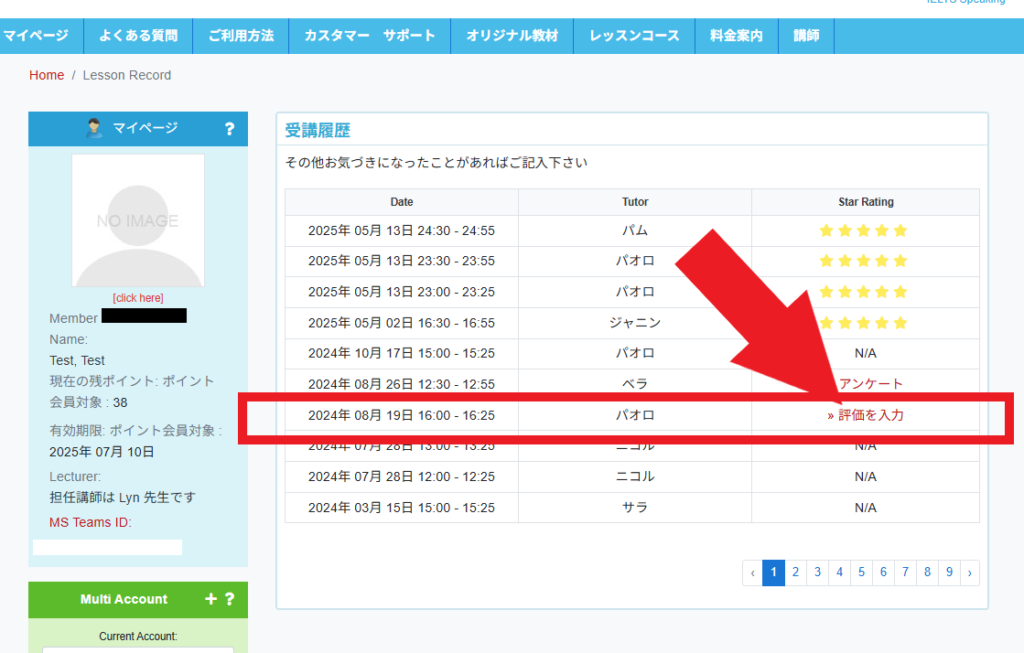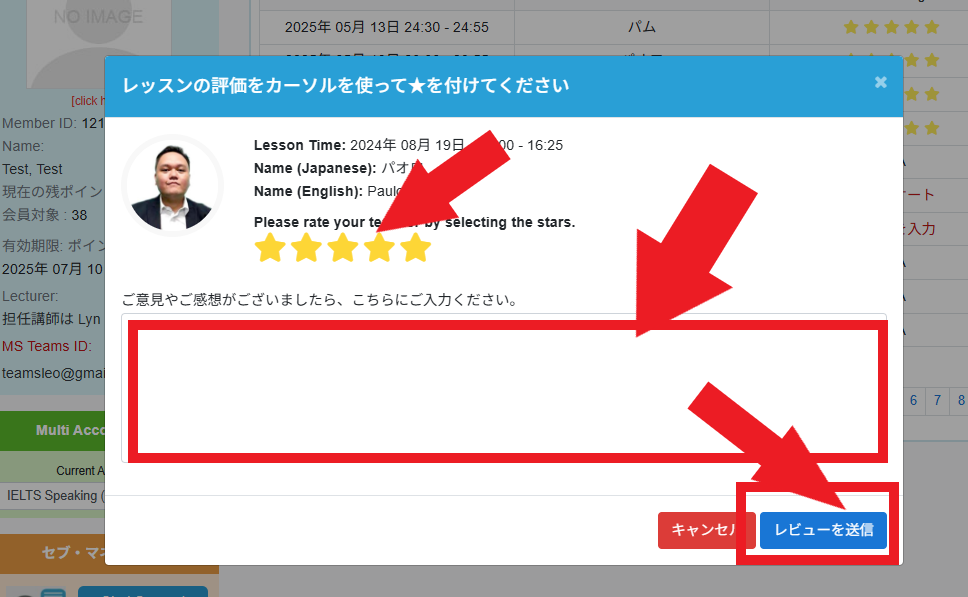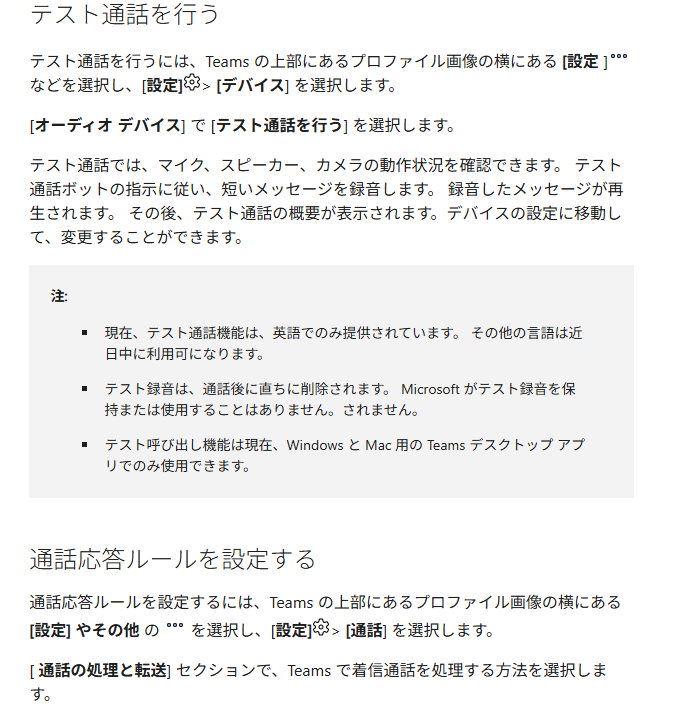
※ マイページ上部メニュー「料金案内」からご購入されますと、ポイントが自動的に即時付与されます。


マイチューターでは、Teamsミーティングの招待URL形式ではなく、アプリからTemasコールを受信する形式を採用しています。Teams機能を効果的に活用するためにアプリ形式を利用しています。
この形式は、Microsoft Teamsのアプリをインストールし、Teamsアカウントでログインしている場合に利用できます。
「Teamsにログインできない」「講師からコンタクトが送られてこない」「講師からコールがない」など、緊急時には、Teamsコール アイコンからレッスンに参加することもできます。ただし、Teamsコール アイコンからレッスンに参加した場合、Teams機能に制限がかかることがございますのでご留意ください。
※ 注意: プライバシーの設定が「オフ(非表示)」になっていると講師がコールできません。
レッスンの品質向上のため、評価(Star Rating)にご協力をお願いいたします。
ご希望の方は、ご意見・ご感想もあわせてご記入ください。
評価(Star Rating) は、レッスン終了時にマイページに1回だけポップアップ表示されますので、
ご対応いただけますと幸いです。
ポップアップ表示が消えた後は以下の手順で「評価」をご入力ください。
1 「評価を入力する」をクリック

2. 該当のレッスンを選択し、「評価を入力」をクリック

3-1 カーソルを使って5段階評価をお願いします。 (必須)
3-2 ご意見、ご感想等ございましたらご入力ください(任意)
3-3 「レビューを送信」をクリック

音声が聞こえない場合や、相手に自分の音声が届いていない場合には下記の手順でご確認ください。
①まずはデバイスの音量設定を確認
パソコンやタブレットなどの利用しているデバイスの音量がゼロになっていないかをまず確認します。
②Teamsの設定でミュート(音声オフ)になっていないか確認します。
画面下部のマイクアイコンがミュート解除と表示されている場合、そこをクリックしてください。
③マイク本体がミュートになっていないかを確認
スマートフォンではなく、パソコンにマイクを接続してteamsを使用している場合、マイク本体にオンオフのスイッチがついている場合があります。マイクがオフなっている場合にはオンにしてください。
④他のビデオ電話ツールを立ち上げていないか確認
非常に注意したいのがTeamsと同時にZOOMなどのビデオ電話ツールを使用してる場合。複数のオンライン会議ツールを立ち上げているとTeams以外で音声が使用されてしまい、Teamsでは相手に声が届かない場合があります。
その場合には、一度Teamsを退出して、Teams以外のオンライン会議ツールなどを全てログアウトしてから、再度Zoomに入室してください。
⑤Teamsのオーディオ設定を確認する


講師からコールがない場合に、緊急対応として、マイページ「講師への連絡」から「Temas コール アイコン」を使いレッスンに参加することができます。
● レッスン時間5分前ですが、講師からコンタクトリクエスト(連絡先承認リクエスト)が届きません。(初めての講師の場合)
レッスン時間5分前で、講師からコンタクトリクエストが届かない場合に、緊急対応として、マイページ「講師への連絡」から「Teams コール アイコン」を使いレッスンに参加することができます。
● 講師からTeamsミーティング招待URLが送られてこない
マイチューターでは、Teamsミーティングの招待URL形式ではなく、アプリからTemasコールを受信する形式を採用しています。Teams機能を効果的に活用するためにアプリ形式を利用しています。そのため、講師から招待URLは送られてきません。初めての講師の場合、レッスン開始の10~30分前に講師から送られてくるコンタクトリクエスト(連絡先リクエスト)を承認し、その後、講師からのTeamsコールを受信してレッスンが始まります。
● プライバシーの設定が「オフ(非表示)」になっていると講師がコールできません。
● Teams 登録内容を確認する(マイプロフィールの見方)
● 登録したTeams IDを変更したい
ご希望のZOOM IDを「カスタマーサポート」からご連絡ください。
━━━━━━━━━━━━━━━━━━━━━━━━━━━━━━━━━━━━━━━━━━━━━
Chona (チョナ)先生

担当:英検 ┃TOEIC ┃TEAP┃小中学生クラス ┃ビジネス会話 ┃ 日常会話
ミンダナオ国際大学 英語学部卒、 講師歴 10年 日本語対応
趣味:音楽、読書
講師歴:10年
※ TOEFL, IELTS は担当外となりますのでご了承ください。
※ 日本語対応
チョナは日本の英会話スクールで3年間活躍してきた英語講師です。 10年以上の講師歴があり、指導力も高く評価をいただいております。
5年間日本に住んでいましたので日本語でのコミュニケーションができます。
明るく親しみやすく日本語も話しますので、英語初級者やお子様にも大変人気があります。
🔷🔷🔷🔷🔷🔷🔷🔷🔷🔷🔷🔷🔷🔷🔷🔷🔷🔷🔷🔷🔷🔷🔷🔷🔷🔷🔷🔷🔷🔷
Sarah (サラ)先生

担当:TOEFL┃ IELTS ┃英検 ┃TOEIC ┃TEAP┃小中学生クラス ┃ビジネス会話 ┃ 日常会話
AKLAN STATE 大学 建築学部卒 講師歴5年 TESOL & TEYL 資格, TEFL資格 |
趣味:音楽、読書
講師歴:5年
サラは、英語の4技能(聞く・話す・読む・書く)すべてにおいて卓越した力を持ち、IELTS、TOEFL、TOEIC、英検など、各種英語検定試験対策において最も信頼されている講師です。
生徒一人ひとりのレベルや目的に応じて、熱心かつ的確に指導を行います。
発音はネイティブレベルで、美しく聞き取りやすいため、リスニングやスピーキングの向上にも最適です。
明るく親しみやすい性格で、レッスンはテンポよく進み、25分があっという間に感じられることでしょう。
🔷🔷🔷🔷🔷🔷🔷🔷🔷🔷🔷🔷🔷🔷🔷🔷🔷🔷🔷🔷🔷🔷🔷🔷🔷🔷🔷🔷🔷🔷
Rena(レナ)先生
音声を再生する
担当:TOEFL┃ IELTS ┃英検 ┃TOEIC ┃TEAP┃小中学生クラス ┃ビジネス会話 ┃ 日常会話
Cebu Technological 大学 Master in Education 卒
趣味:音楽、ボランティア活動、旅行
講師歴:13年
レナはMaster in Educationの学位をもち、講師歴10年のキャリア豊富な講師です。
英語講師としてシンガポール、台湾、マレーシアのインターナショナルスクールでも活躍されました。
英語4技能全てに卓越した能力をもっており、IELT、TOEFL, TOEIC,英検®など検定試験対策に信頼のおける講師です。
発音はネイティブアメリカン並みで聞き取りやすく、受講者のレベルに合わせて丁寧に指導ができるやさしい先生です。
🔷🔷🔷🔷🔷🔷🔷🔷🔷🔷🔷🔷🔷🔷🔷🔷🔷🔷🔷🔷🔷🔷🔷🔷🔷🔷🔷🔷🔷🔷
Paulo(パオロ)先生

音声を再生する
担当:TOEFL┃ IELTS ┃英検 ┃TOEIC ┃TEAP┃小中学生クラス ┃ビジネス会話 ┃ 日常会話
アテネオ大学院 MA in English 英語教授法修士 卒業
趣味:音楽演奏(サックス、ドラム、ギター)料理
講師歴 11年
パオロは名門大学で英語学部卒業後、同大学院で英語教授法修士を取得した英語指導のプロフェッショナルです。
5年以上の英語講師歴があります。 英語総合力が高く、なるべく簡単にわかりやすく指導することで高く評価されています。
TOEFL,IELTSの指導はもとより、TOEIC,ビジネスの担当講師としてお勧めの講師です
🔷🔷🔷🔷🔷🔷🔷🔷🔷🔷🔷🔷🔷🔷🔷🔷🔷🔷🔷🔷🔷🔷🔷🔷🔷🔷🔷🔷🔷🔷
Joy(ジョイ)先生

音声を再生する
担当:TOEFL┃ IELTS ┃英検 ┃TOEIC ┃TEAP┃小中学生クラス ┃ビジネス会話 ┃ 日常会話
職業別英語:Accounting, Finance, Commerce, Cabin Crew, Tourism
ミンダナオ大学 会計学部 卒 TEFL(英語教授法)資格
趣味:読書、映画鑑賞
講師歴:8年
ジョイはTEFL(英語教授法)資格を持ち英語4技能が特に優れた講師です。 英語講師としての情熱が強く、受講者に対しては献身的なサポートをします。
大学では会計学を学んでおりますので、ビジネス英語、Accounting クラス受講者にもお勧めいたします。
🔷🔷🔷🔷🔷🔷🔷🔷🔷🔷🔷🔷🔷🔷🔷🔷🔷🔷🔷🔷🔷🔷🔷🔷🔷🔷🔷🔷🔷🔷
Pam(パム)先生

音声を再生する
担当:TOEFL┃ IELTS ┃英検 ┃TOEIC ┃TEAP┃小中学生クラス ┃ビジネス会話 ┃ 日常会話
職業別英語:Medicine / Pharmaceutical / Accounting / Finance / Commerce
Holy cross 大学 商学部 卒
趣味:ダンス、読書
講師歴:13年
パムは、英語4技能が特に優れた講師です。 講師歴が13年あり経験豊富です。
発音アクセントはネイティブ並みで聴きやすい英語です。
アメリカン・アクセント、ブリティッシュ・アクセント、どちらも教えることができます。
IELTS/TOEFLはもとよりあらゆる英語クラスの指導経験があります。
大変明るい性格で誰にでも親しみ易く、穏やかな講師です。
職業別英語クラスではMedicine / Pharmaceutical/Accounting ,Finance, Commerceを担当します。
🔷🔷🔷🔷🔷🔷🔷🔷🔷🔷🔷🔷🔷🔷🔷🔷🔷🔷🔷🔷🔷🔷🔷🔷🔷🔷🔷🔷🔷🔷
Micah(マイカ)先生

音声を再生する
担当:TOEFL┃ IELTS ┃英検 ┃TOEIC ┃TEAP┃小中学生クラス ┃ビジネス会話 ┃ 日常会話
Victory Elijah 大学 教育学部卒 講師歴 2年
趣味:映画、水泳
講師歴:2年
英語の4技能すべてにおいて卓越した能力を持つ講師で、IELTS、TOEFL、TOEIC、英検などの検定試験対策で高い信頼を得ています。
これまでのキャリアの中で、特にTOEFLやTOEICの指導を数多く手掛けてきました。
発音やアクセントが正確で聞き取りやすく、スピーキングクラスにおいてもおすすめの講師です。
非常に明るく親しみやすい性格を持ち、初級者から上級者まで、各生徒の目的やニーズに合わせた熱心かつ丁寧なレッスンを提供します。
🔷🔷🔷🔷🔷🔷🔷🔷🔷🔷🔷🔷🔷🔷🔷🔷🔷🔷🔷🔷🔷🔷🔷🔷🔷🔷🔷🔷🔷🔷
━━━━━━━━━━━━━━━━━━━━━━━━━━━━━━━━━━━━━━━━━━━━━
Arlene(アリーン)先生

音声を再生する
担当:TOEFL┃ IELTS ┃英検 ┃TOEIC ┃TEAP┃小中学生クラス ┃ビジネス会話 ┃ 日常会話
フィリピン大学 経営学部卒 IELTS OA 8.0
趣味:ピアノ、旅行、読書
講師歴:15年
英語の4技能すべてにおいて卓越した能力を持ち合わせており、IELTS、TOEFL、TOEIC、英検などの検定試験対策における最も信頼される講師の一人です。名門フィリピン大学を卒業後、英語教師の指導者として15年以上の経験を持っています。英語講師としてのキャリアの中で特に注目される実績として、英国資本のIELTS専門学校での長期間の指導経験があります。2016年に一度だけ受験したIELTSでは、スコア8.0を記録しました。そのスコアは少し古いため、現在の実力はさらに高い(8.5-9.0)と自負しています。
特に、中級者以上で各試験においてハイスコアを目指す受講生に強く推薦される講師です。
🔷🔷🔷🔷🔷🔷🔷🔷🔷🔷🔷🔷🔷🔷🔷🔷🔷🔷🔷🔷🔷🔷🔷🔷🔷🔷🔷🔷🔷🔷
Iris(アイリス)先生

音声を再生する
担当: TOEFL┃ IELTS ┃英検 ┃TOEIC ┃TEAP┃小中学生クラス ┃ビジネス会話 ┃ 日常会話
職業別クラス:Medicine, Nursing, Pharmaceutical
バギオ大学 看護学科卒 看護師資格者 講師歴 11年
趣味:映画、読書
講師歴:11年
英語の4技能すべてに卓越した能力を持っており、IELTS、TOEFL, TOEIC、英検などの検定試験対策に最も信頼のおける講師です。
英語教師の指導者として11年間活躍してきました。
IELTSスコア8.0以上を目指す留学希望者を対象とした英語スクールで中心的な役割を果たし、豊富な経験を積んできました。
英語の中級者及び上級者向けの講師としての資格を持っています
また、看護師国家資格も取得しており、医療英語にも明るいため、職業別レッスンプログラム(Medicine, Nursing, Pharmaceutical)を担当します。
🔷🔷🔷🔷🔷🔷🔷🔷🔷🔷🔷🔷🔷🔷🔷🔷🔷🔷🔷🔷🔷🔷🔷🔷🔷🔷🔷🔷🔷🔷
Franz(フレンズ)先生

担当:TOEFL┃ IELTS ┃英検 ┃TOEIC ┃TEAP┃小中学生クラス ┃ビジネス会話 ┃ 日常会話
Colegio de Dagupan 英文科卒 公認英語教師資格, IELTS OA 8.0
趣味:編み物、映画、アニメ
講師歴 10年
フレンズは大学英文科を卒業後、10年以上の英語講師歴があり、公認英語講師資格者です。
英語4技能全てに卓越した能力をもっており、IELTS、TOEFL, TOEIC、英検など検定試験対策に最も信頼のおける講師です。
発音アクセントはネイティブ並みで非常にテンポが良く聞き易い英語です。
職務キャリアの多くは英語講師の指導者であり、特にIELTSのスピーキングとライティングのトレーナーとして活躍してきました。
ちなみに、特に準備もせずに受けたIELTSのバンドスコアは8.0でした。
中・上級者向けに、受講者一人ひとりの目的に沿った熱心で丁寧なレッスン指導ができます。
🔷🔷🔷🔷🔷🔷🔷🔷🔷🔷🔷🔷🔷🔷🔷🔷🔷🔷🔷🔷🔷🔷🔷🔷🔷🔷🔷🔷🔷🔷
Jannine(ジャニン)先生

担当:TOEFL┃ IELTS ┃英検 ┃TOEIC ┃TEAP┃小中学生クラス ┃ビジネス会話 ┃ 日常会話
Visayas 大学 教育学部 卒
趣味:クライミング
講師歴:6年
ジャニンは教育学部を卒業後、4年以上の英語講師歴があり、前職の英語学校では、日本教室で英語を教えていた経歴もあります。英語4技能全てに卓越した能力をもっており、IELT、TOEFL, TOEIC,英検など検定試験対策に最も信頼のおける講師です。大変明るい性格で誰にでも親しみ易く、受講者一人ひとりの目的に沿った熱心で丁寧なレッスン指導ができます。英語初心者、お子様や小中学生にもお勧めしたい講師です。
勤務成績も優秀で、最も臨時休講の少ない講師の一人です。
🔷🔷🔷🔷🔷🔷🔷🔷🔷🔷🔷🔷🔷🔷🔷🔷🔷🔷🔷🔷🔷🔷🔷🔷🔷🔷🔷🔷🔷🔷
Haydee(ハイディ)先生

担当:TOEFL┃ IELTS ┃英検 ┃TOEIC ┃TEAP┃小中学生クラス ┃ビジネス会話 ┃ 日常会話
ブロークンシャー大学 教育学部 卒
趣味:読書、音楽
講師歴:6年
ハイディは、英語講師として6年のキャリアがあります。
英語4技能全てに卓越した能力をもっており、IELT、TOEFL、TOEIC、英検など検定試験対策に最も信頼のおける講師です。
発音はネイティブアメリカン並みで聞き取りやすい英語です。
明るく献身的なレッスンは受講者の潜在能力を100%発揮させることができます。
日常会話・ビジネス会話を基本からしっかり学びたい方へ丁寧にご指導いたします。
🔷🔷🔷🔷🔷🔷🔷🔷🔷🔷🔷🔷🔷🔷🔷🔷🔷🔷🔷🔷🔷🔷🔷🔷🔷🔷🔷🔷🔷🔷
Bella(ベラ)先生

音声を再生する
担当:TOEFL┃ IELTS ┃英検 ┃TOEIC ┃TEAP┃小中学生クラス ┃ビジネス会話 ┃ 日常会話
職業別英語:Tourism、Cabin Crew、Technology
フィリピン Women’s大学 ホテル&リゾート経営学部 卒
趣味:読書、アニメ
講師歴:10年
ペラは講師歴10年で、TOEFL/IELTSの専門クラスを長年受け持ち、これまで数多くの中国、韓国、日本人の留学を成功させて参りました。
米系大手通信会社のテクニカルサポートを担当していた職歴もございますので、アメリカンイングリッシュをマスターしています。
教え方が丁寧でやさしい性格もあり、特に小、中学生に人気が高い講師です。アメリカン・アクセント、ブリティッシュ・アクセント、どちらも教えることができます。
🔷🔷🔷🔷🔷🔷🔷🔷🔷🔷🔷🔷🔷🔷🔷🔷🔷🔷🔷🔷🔷🔷🔷🔷🔷🔷🔷🔷🔷🔷
マイチューターでは、質の高い個別指導を実現するため、業界トップクラスの好待遇で優秀な講師を集めています。 IELTS,TOEFLなど試験対策に熟知したプロ集団です。
マイチューターの講師について ⇒
※ 講師紹介(プロフィール)はマイページからでもご覧いただけます。
※ レッスンの品質向上のため、評価(Star Rating)にご協力をお願いいたします。
① ② ③
🔷🔷🔷🔷🔷🔷🔷🔷🔷🔷🔷🔷🔷🔷🔷🔷🔷🔷🔷🔷🔷🔷🔷🔷🔷🔷🔷🔷🔷🔷
Cat(キャット)先生
担当:TOEFL┃ IELTS ┃英検 ┃TOEIC ┃TEAP┃小中学生クラス ┃ビジネス会話 ┃ 日常会話
Benguet State大学 情報工学科卒 IELTS OA 7.5
趣味:Writing, Handicraft
講師歴 10年
英語4技能全てに卓越した能力をもっており、IELTS、TOEFL, TOEIC、英検など検定試験対策に最も信頼のおける講師です。
発音アクセントはネイティブ並みで非常にテンポが良く聞き易い英語です。
英語教師の指導者としての経験に加え、カンボジアのインタースクールで2年間英語講師として活躍してまいりました。
ちなみに、特に準備もせずに受けたIELTSのバンドスコアは7.5でした。
現在は大学院で心理学を学んでおり、教育現場では受講者のコーチングに役立てています。
初心者から上級者まで幅広い受講者に対応できる能力があります。
🔷🔷🔷🔷🔷🔷🔷🔷🔷🔷🔷🔷🔷🔷🔷🔷🔷🔷🔷🔷🔷🔷🔷🔷🔷🔷🔷🔷🔷🔷
Kim(キム)先生 日本語対応可

音声を再生する
担当:TOEFL┃ IELTS ┃英検 ┃TOEIC ┃TEAP┃小中学生クラス ┃ビジネス会話 ┃ 日常会話
職業別英語:Technology / Tourism / Cabin Crew
ミンダナオ国際大学 英語学部 卒
趣味:読書 映画 アニメ
講師歴:9年
キムは大学では英語を専攻し、英会話スクールとAT&T系列のコールセンターの職歴があります。
TOEIC, TOEFL,IELTS ビジネスクラスを担当しますが、日本語も少し話せますので、小中学生にもお勧めの講師です。
コールセンターでは米国人顧客へのカスタマーサポートを担当し、発音もしっかりしています。
日本の文化に大変興味があり、気さくで明るく元気な性格です。
🔷🔷🔷🔷🔷🔷🔷🔷🔷🔷🔷🔷🔷🔷🔷🔷🔷🔷🔷🔷🔷🔷🔷🔷🔷🔷🔷🔷🔷🔷
Allen(アレン)先生 日本語対応可

担当:TOEFL┃ IELTS ┃英検 ┃TOEIC ┃TEAP┃小中学生クラス ┃ビジネス会話 ┃ 日常会話
南フィリピン科学技術大学 化学サイエンス学部 卒
趣味:日本のマンガ、アニメ、読書
講師歴:5年
アレンはインターナショナル語学学校でIELTS、TOEICトレナーとして指導され、当スクールに参りました。
発音はアメリカンイングリッシュをマスターし、ネイティブ並です。
日本のカルチャーやアニメに関心があり、日本語も少し話せます。
英語4技能全てに卓越した能力をもっており、IELT、TOEFL, TOEIC,英検など検定試験対策に信頼のおける熱意のある講師です。
🔷🔷🔷🔷🔷🔷🔷🔷🔷🔷🔷🔷🔷🔷🔷🔷🔷🔷🔷🔷🔷🔷🔷🔷🔷🔷🔷🔷🔷🔷
Joana (ジョアンナ)
担当クラス
担当:TOEFL┃ IELTS ┃英検 ┃TOEIC ┃TEAP┃小中学生クラス ┃ビジネス会話 ┃ 日常会話
Saint Thomas Aquinas 大学 ホテル・レストラン・観光学の理学士卒
趣味: 読書、韓国ドラマ
講師歴:9年

スピーキング、ライティング、リーディングとリスニングの指導において9年以上の経験を持ち、多様な生徒層への指導実績があります。
問題解決、創造力、そして生涯学習への情熱を育む、魅力的な学習環境の創出に定評があります。
大変明るい性格で誰にでも親しみ易く、受講者一人ひとりの目的に沿った熱心で丁寧なレッスン指導ができます。
ご挨拶 2025年2月12日
こんにちは!
私はESL(英語を母国語としない方への英語指導)の講師として9年間の経験があり、楽しく、魅力的で、そして生徒一人ひとりに合わせたレッスンを提供することを大切にしています。初心者から上級者まで、あらゆるレベル・年齢の生徒さんに英語を教えることに情熱を持っています。これまで、中国、日本、ベトナム、ブラジル、イスラエル、台湾、韓国など、さまざまな国や文化的背景を持つ生徒さんを指導してきました。
私のレッスンでは、スピーキング、ライティング、リーディング、リスニングをバランスよく指導し、生徒さんが自信を持ってスキルを向上できるよう、安心して学べる楽しい雰囲気を大切にしています。
英語を教えることは、私にとってとてもやりがいのある仕事です。生徒さん一人ひとりの可能性を最大限に引き出し、目標達成をサポートすることに全力を尽くします!
どうぞよろしくお願いします!
🔷🔷🔷🔷🔷🔷🔷🔷🔷🔷🔷🔷🔷🔷🔷🔷🔷🔷🔷🔷🔷🔷🔷🔷🔷🔷🔷🔷🔷🔷
Angel (エンジェル)先生 
音声を再生する
担当:TOEFL┃ IELTS ┃英検 ┃TOEIC ┃TEAP┃小中学生クラス ┃ビジネス会話 ┃ 日常会話
CITY COLLEGE OF TAGAYATAY大学 教育学部 英文科卒
公認英語教師資格、TESOL(英語教授法)認定証
趣味: ギター、ウクレレ、歌うこと
講師歴 4年
<熱意と献身を持つ英語講師>
スピーキング、ライティング、リーディングとリスニングの指導において5年以上の経験を持ち、多様な生徒層への指導実績があります。
問題解決、創造力、そして生涯学習への情熱を育む、魅力的な学習環境の創出に定評があります。
個別指導、革新的なレッスンプランの作成、そしてサポートの行き届いた教室環境の構築を通じて、生徒の成功に尽力しています。
カリキュラム、評価戦略、そしてテクノロジーを活用した学習成果の向上に精通しています。
学術的な卓越性と生徒の成長を重視する教育機関において、教育への情熱と専門知識を活かして貢献することを目指しています。
🔷🔷🔷🔷🔷🔷🔷🔷🔷🔷🔷🔷🔷🔷🔷🔷🔷🔷🔷🔷🔷🔷🔷🔷🔷🔷🔷🔷🔷🔷
Romey(ロミー)先生
担当:TOEFL┃ IELTS ┃英検 ┃TOEIC ┃TEAP┃小中学生クラス ┃ビジネス会話 ┃ 日常会話
南イースタン大学 教育学部 卒
趣味:写真、読書、旅行
講師歴 8年

音声を再生する
ロミーは講師歴8年でTOEFL/ IELTS の専門クラスを長年受け持ち、これまで数多くの受講者の留学試験対策サポートをして参りました。 4技能に優れた指導力を持った講師です。 英語講師としての誇りと情熱を誰よりも強く持っており、受講者のレベルや要望に合わせてレッスンを組み立てる能力があります。
TOEIC、ビジネス英語指導でも高い評価を受けており、ビジネス英語のスキルアップを目指す受講者には大変お勧めする講師です。
🔷🔷🔷🔷🔷🔷🔷🔷🔷🔷🔷🔷🔷🔷🔷🔷🔷🔷🔷🔷🔷🔷🔷🔷🔷🔷🔷🔷🔷🔷
Shane(シェーン)先生

担当:TOEFL┃ IELTS ┃英検 ┃TOEIC ┃TEAP┃小中学生クラス ┃ビジネス会話 ┃ 日常会話
南フィリピン大学院 英語教職修士(M.Ed) 卒
趣味:絵画、旅行
講師歴 7年
シェーンは大学院 英語教職修士(M.Ed) を卒業しております。
大学院卒業後は公認英語講師資格も取得しており、英語講師のエリートと言えます。
英語4技能全てに卓越した能力をもっており、IELT、TOEFL, TOEIC,英検®など検定試験対策に最も信頼のおける講師です。
発音はネイティブアメリカン並みで聞き取りやすい英語です。
性格は明るく、適応能力が高いのであらゆるレベルの成績を向上させることができます。
🔷🔷🔷🔷🔷🔷🔷🔷🔷🔷🔷🔷🔷🔷🔷🔷🔷🔷🔷🔷🔷🔷🔷🔷🔷🔷🔷🔷🔷🔷
サービスの品質向上にご協力いただけますと幸いです。
1. マイページ トップ画面にある「アンケートに答える!」をクリックする


2. 4つの評価項目にご回答いただき、よろしければご意見、ご要望などをご入力ください。
